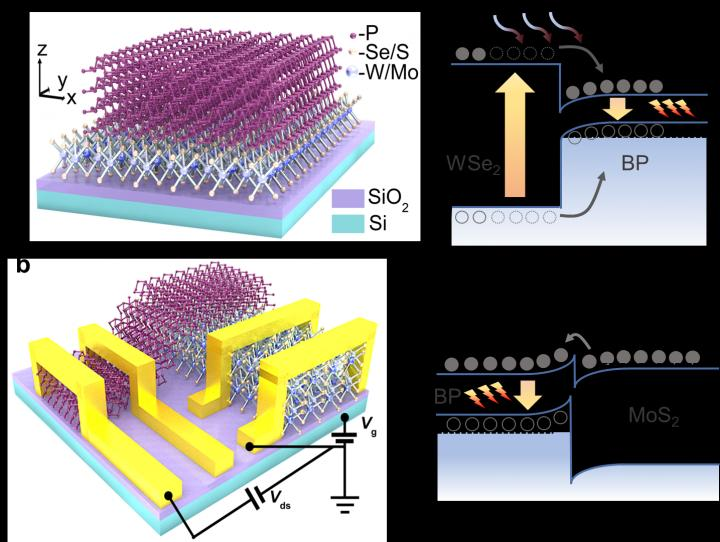Jul 13 2020
Mid-infrared (MIR) spectra fine extensive applications for communications, molecule characterizations, and thermal imaging. In MIR technologies, the MIR light source is the main component. MIR light-emitting diodes (LED) offer portability, narrow linewidth, and low power consumption.
 (a) Schematic diagram of the BP-WSe2 heterostructure. Under the excitation of light, the electron and hole pairs in WSe2 can be efficiently transmitted to BP, thereby enhancing its MIR photoluminescence. (b) Schematic diagram of the BP-MoS2 heterojunction diode. Under a positive bias voltage between BP and MoS2, the electrons on the conduction band of MoS2 can overcome the barrier, enter into the conduction band of BP, and recombine with abundant holes in BP. Thereby electroluminescence is achieved. Image Credit: by Xinrong Zong, Huamin Hu, Gang Ouyang, Jingwei Wang, Run Shi, Le Zhang, Qingsheng Zeng, Chao Zhu, Shouheng Chen, Chun Cheng, Bing Wang, Han Zhang, Zheng Liu, Wei Huang, Taihong Wang, Lin Wang, and Xiaolong Chen.
(a) Schematic diagram of the BP-WSe2 heterostructure. Under the excitation of light, the electron and hole pairs in WSe2 can be efficiently transmitted to BP, thereby enhancing its MIR photoluminescence. (b) Schematic diagram of the BP-MoS2 heterojunction diode. Under a positive bias voltage between BP and MoS2, the electrons on the conduction band of MoS2 can overcome the barrier, enter into the conduction band of BP, and recombine with abundant holes in BP. Thereby electroluminescence is achieved. Image Credit: by Xinrong Zong, Huamin Hu, Gang Ouyang, Jingwei Wang, Run Shi, Le Zhang, Qingsheng Zeng, Chao Zhu, Shouheng Chen, Chun Cheng, Bing Wang, Han Zhang, Zheng Liu, Wei Huang, Taihong Wang, Lin Wang, and Xiaolong Chen.
After the rediscovery of thin-film Black Phosphorus (BP) in 2014, it has gained much attention because of its special properties, such as tunable bandgap, high carrier mobility, and in-plane anisotropy, etc. All these make BP a potential material for applications in optoelectronics and electronics.
BP contains a thickness-dependent (0.3 to 2 eV) bandgap, the size of which can be further manipulated by adding a chemical doping or external electric field. Thus, thin-film BP has been considered as a star MIR material.
Earlier studies primarily concentrated on few-layer BP flakes (with less than five layers) and luminescence properties of the monolayer. But new studies show that thin-film BP (with more than seven layers) exhibits notable photoluminescence properties in the MIR region.
Scientists have hypothesized a novel van der Waals (vdW) heterostructure for MIR light-emission applications, which has been developed from BP and TMDC (like MoS2 and WSe2).
The BP-WSe2 heterostructure develops a type-I band alignment as per the DFT calculation. Thus, the hole and electron pairs in the monolayer WSe2 can be transported efficiently into the narrow-bandgap BP, thus improving the MIR photoluminescence of thin-film BP. An enhancement factor of approximately 200% was obtained in the 5nm-thick BP-WSe2 heterostructure.
At the same time, the BP-MoS2 heterostructure develops a type-II band alignment. A natural PN junction is developed at the interface between p-type BP and n-type MoS2. Upon applying a positive voltage bias between MoS2 (Vds > 0) and BP, electrons in the conduction band of MoS2 can cross the barrier and make their way into the conduction band of BP.
Simultaneously, most holes are blocked at the interface within BP because of the huge Schottky barrier of the valence band. Consequently, an efficient MIR electroluminescence is realized in the BP-MoS2 heterostructure.
The BP-TMDC vdW heterostructures exhibit several advantages, like good compatibility with silicon technology, high efficiency, and simple fabrication process. Thus, it offers a potential platform for examining silicon-2D hybrid optoelectronic systems.
Journal Reference:
Zong X., et al. (2020) Black phosphorus-based van der Waals heterostructures for mid-infrared light-emission applications. Light: Science & Applications. doi.org/10.1038/s41377-020-00356-x.